THERE IS NO GOD BUT ELVIS AND SINATRA IS HIS PROPHET
Las Vegas Trip Report
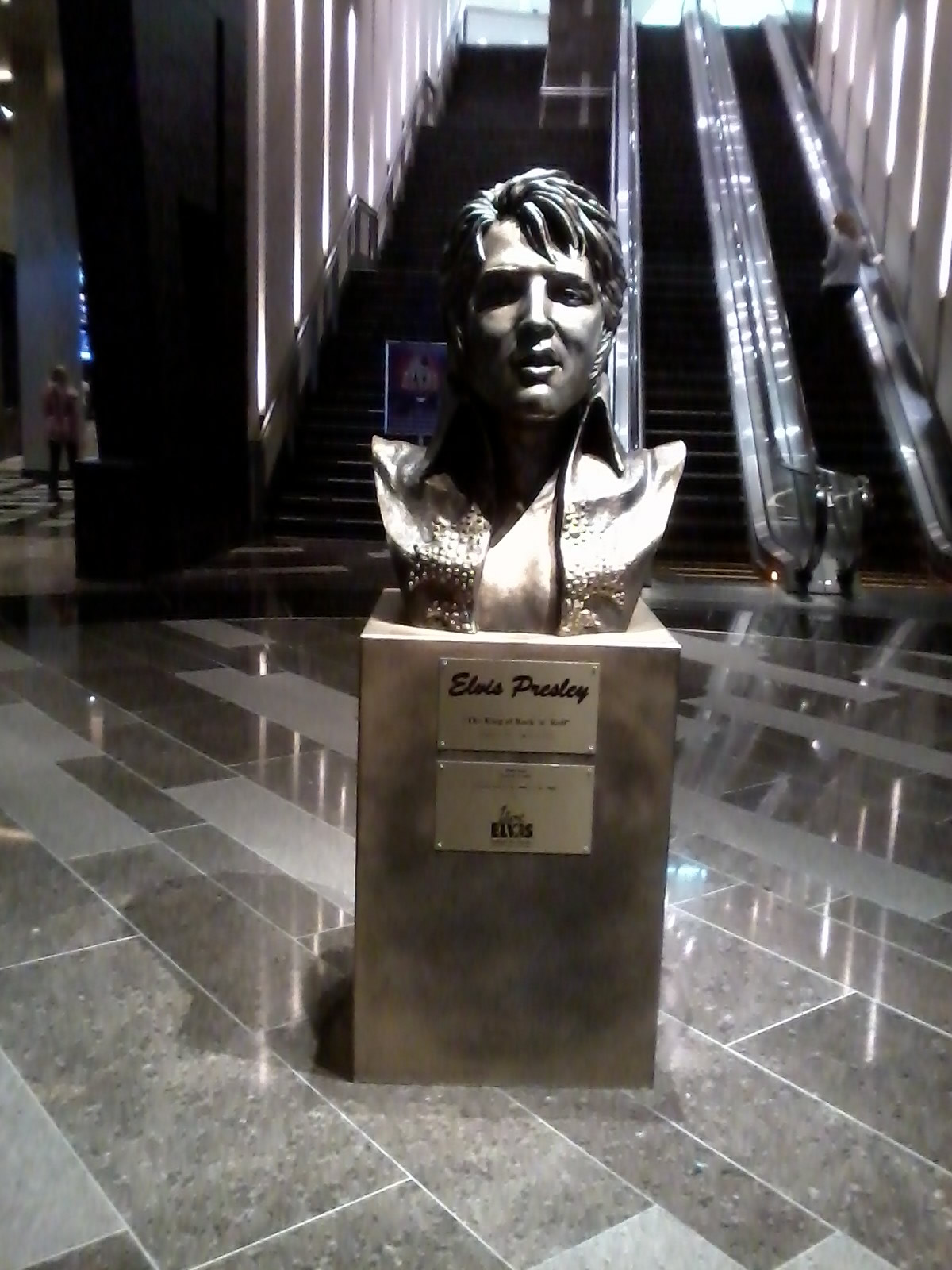 Last January my wife and I went to Las Vegas and the SHOT Show. We left home on January 16th
and returned the 22nd flat-out exhausted, and somewhat poorer, though not
because of gambling, something in which we have no interest at all. Not a penny did we wager,
though God knows there were plenty of opportunities. Las Vegas is, among
many other things, a monument to the truth of Barnum's assertion that there is
a sucker born every minute.
Last January my wife and I went to Las Vegas and the SHOT Show. We left home on January 16th
and returned the 22nd flat-out exhausted, and somewhat poorer, though not
because of gambling, something in which we have no interest at all. Not a penny did we wager,
though God knows there were plenty of opportunities. Las Vegas is, among
many other things, a monument to the truth of Barnum's assertion that there is
a sucker born every minute.
I wish I owned a company making slot machines. There were none in our hotel
room nor in public toilets (at least the ones I saw) but they were
everywhere else, including at the airport, in the hall leading from the gates where your arrive to the ones you go to for your return flight.
There must be a million slot machines in the city, probably more. All the ones I saw seemed to be quite new, which made me wonder what happens to
the old ones. Is there some landfill in
the desert filled with old slot machines? A Slot Machine Graveyard, where broken and elderly ones go to die?
The first time I encountered slot machines was in 1980 in Reno. Today's slot machines are different. For one thing it seems they no longer take coins or tokens. No, they
take credit and DEBIT cards, though it's hard to imagine that anyone, even in Las Vegas,
is dumb enough to put a debit card in a slot machine. (What am I saying? Of course there are people dumb enough to do that.) Some slot machines also take bills, but -purely for your
convenience, of course-you can buy bar-coded "tickets" from the cashiers to
insert into them.
 In the old days, a significant part of the "draw" of a bank of slot machines was the noise coins made
falling into the tray at the bottom: the whirring of the wheels was periodically interrupted broken by the crashing and jangling announcing
that someone had "won" (and therefore was in a position to feed it
all back in again). That's gone, along with the expense and trouble of handling coins for the casinos.
In the old days, a significant part of the "draw" of a bank of slot machines was the noise coins made
falling into the tray at the bottom: the whirring of the wheels was periodically interrupted broken by the crashing and jangling announcing
that someone had "won" (and therefore was in a position to feed it
all back in again). That's gone, along with the expense and trouble of handling coins for the casinos.
The solution to the "announcement" issue in
the newer, presumably more efficient, slot machines is innumerable flashing
nights and boing-boing-boinging sound
makers. Every one of the hundreds upon hundreds of slot machines on a
casino floor is generating loud noises all the time, not just when someone wins, and whether someone is sitting at
it or not...the cacophony is beyond belief, far worse than the dinging and
banging of the old machines. It's impossible to have a
conversation, let alone think logically in one of these places. Of course,
that's the idea: logical thinking and gambling are pretty much
incompatible concepts.
Slot machines are now all electronic. There are no more spinning
and chattering wheels, everything is done on video screens. But while the purely mechanical
slots are gone, the new ones still have a handle on the side. This must be solely for the sake of
tradition: as far as I could tell the handle does nothing: you push a button to "spin" the images on the screen. Perhaps the term "One-Armed
Bandit" is so powerfully entrenched in Las Vegas tradition and so firmly fixed in gamblers' minds that replacing it with "Armless
Bandit" is unthinkable. Actually not all the old slots are gone: some have been retired to old and shabby casinos in "Old Downtown"
Las Vegas. Nevertheless, these establishments usually had advertising
signs that actually stated "WE HAVE COIN FREE SLOTS" so the new ones
must be popular with the visitors. In time the Slot Machine Graveyard will be filled with mechanical corpses, all with a single arm.
There is absolutely no place to sit down in a casino except at a slot machine or a gaming
table. This is, of course, based on the trenchant observation that sitting people aren't spending
money. At any given moment in a large casino there will be a
thousand or more people milling around, not to mention almost as many more passing
through on their way to a restaurant or their hotel rooms, and not a few just ambling
around drunk and susceptible. Every one of these people represents a potential few bucks
in a slot machine. If you walk past 500
slots on your way across the casino to the elevators, perhaps one will catch
your eye and lead to an impulsive "donation" to the casino's bottom
line.
a restaurant or their hotel rooms, and not a few just ambling
around drunk and susceptible. Every one of these people represents a potential few bucks
in a slot machine. If you walk past 500
slots on your way across the casino to the elevators, perhaps one will catch
your eye and lead to an impulsive "donation" to the casino's bottom
line.
In addition to the slots there are roulette wheels, blackjack tables, craps tables, poker rooms, and God alone knows how many variations of games of chance. Not so many as there are slots, but in a big casino, a couple of hundred game tables wouldn't be at all unusual. Needless to say, a drunken and confused guest at a blackjack table is something every casino operator loves to think about. In many casinos so long as you're "playing" something the drinks are on the house.

Architecturally, casinos run to a pattern. Surely there must be architects who specialize in designing them. First of all, they're gigantic. I mean really gargantuan edifices, so big that when you step out on the street (where you have to fight your way through hordes of people) to walk from, say, the Bellagio to the MGM Grand, you THINK you're within walking distance of your goal: but the reality is that the distances are much greater than they appear and the huge buildings deceive you. It's much like walking towards a distant mountain range across a flat plain: they're farther off than they look so you keep trudging along, but never seem to get there. I timed a couple of these jaunts. It can easily take 40-60 minutes to walk from one casino to another, even if the two are "next to each other." There seems to be a minimum of 10 minutes' travel time. In general, the difficulty of getting from one to another is deliberate. The casino owners want you to stay in one place and spend all your money with them and not with their competitors. If they make it easy for you to get from their casino to someone else's they lose money.
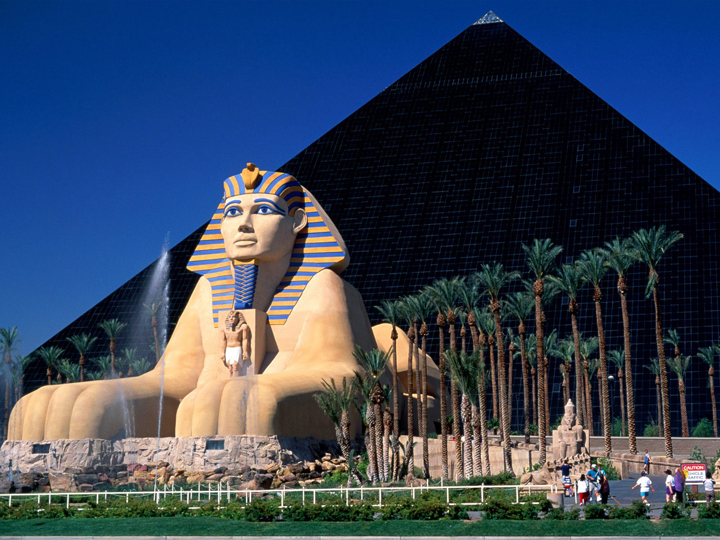 Adjacent casinos are sometimes linked to each other by a tunnel of Shoppes (see
below): whenever this is the case the two are always owned by the same holding company.
One large casino group actually has a tram system to get you from one of their casinos
to another. Once you do reach another casino, there is little to distinguish it from the
one you left 45 minutes before except the "theme." These days
casinos have to have some sort of theme. "Excalibur" is built
to look like a castle, and inside you will find jousting knights and plaster
dragons, women in pointed hats, and wizards. "Paris" is
supposed to represent a street in that city, though the resemblance is...well,
marginal at best.
Adjacent casinos are sometimes linked to each other by a tunnel of Shoppes (see
below): whenever this is the case the two are always owned by the same holding company.
One large casino group actually has a tram system to get you from one of their casinos
to another. Once you do reach another casino, there is little to distinguish it from the
one you left 45 minutes before except the "theme." These days
casinos have to have some sort of theme. "Excalibur" is built
to look like a castle, and inside you will find jousting knights and plaster
dragons, women in pointed hats, and wizards. "Paris" is
supposed to represent a street in that city, though the resemblance is...well,
marginal at best.
"Luxor" was one of my favorites (since I have a professional connection to Egypt). It's a gigantic pseudo-Pharonic pyramid much larger than anything Cheops ever dreamed of having built. The reinforced-concrete Sphinx is in much better shape than that old stone one with the broken nose in Giza. Inside there were fake mummies and "Egyptian" inscriptions on the walls, etc. "New York, New York" is supposed to resemble New York City in about 1940, with replicas of famous New York landmarks: the Brooklyn Bridge, the Empire State and Chrysler buildings, and the Statue of Liberty. And so help me, I am not making this up: in addition to the half-scale Statue of Liberty on the street, inside there is a smaller Statue of Liberty replica, made of...jelly beans!
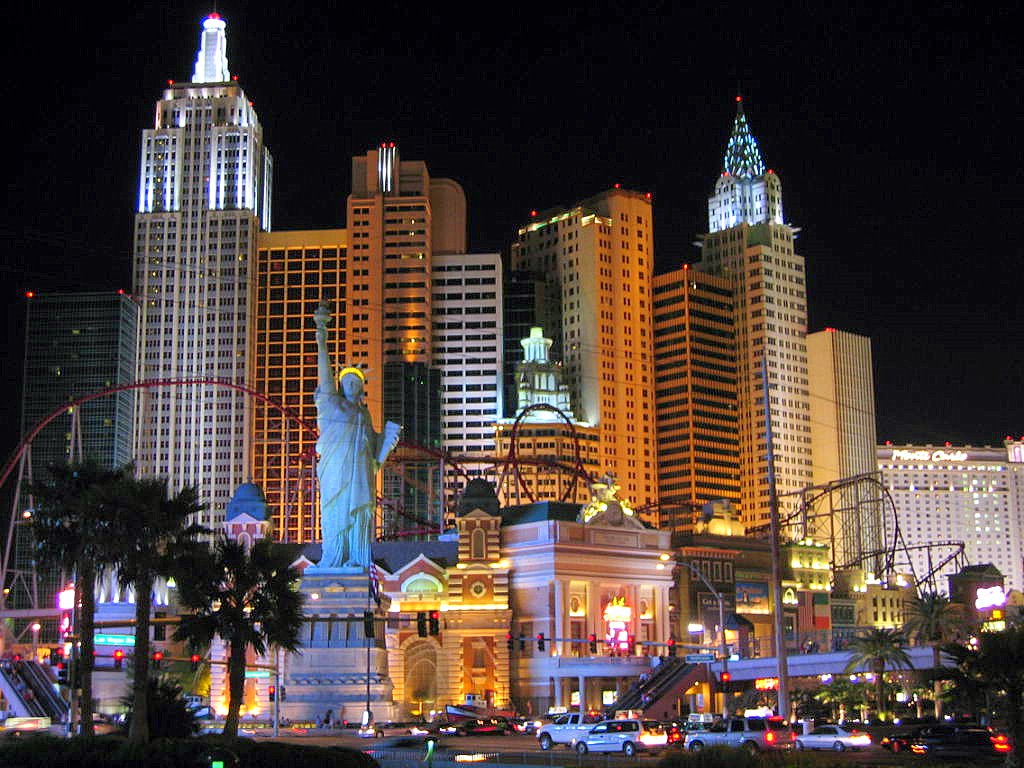

I didn't actually see an Anchorage-themed casino, but if there were one the decor would be artificial (probably animated) sled dogs and cocktail waitresses in skimpy parkas.
Casino buildings are so enormous that even when you finally enter one it can easily take
you 10 minutes to walk the length of the gaming room. You always enter through the
actual casino floor itself. These rooms usually dwarf a Super
Wal-Mart store: 10 acres or so of slots and game tables, connected to the
hotel section of the building by a corridor lined with
"Shoppes."
 I never saw that word spelled any other way than
"Shoppes." The one at left is in the Venetian Casino: and despite the gorgeous sky, it's indoors: the sky is—surprise!—fake, a trompe l'oeil painting. Depending on the casino you're in, the Shoppes sell cheap
junk (Circus Circus), overpriced junk (Bally's) or really, really, expensive Junque (The Venetian, Palazzo, and Bellagio).
I never saw that word spelled any other way than
"Shoppes." The one at left is in the Venetian Casino: and despite the gorgeous sky, it's indoors: the sky is—surprise!—fake, a trompe l'oeil painting. Depending on the casino you're in, the Shoppes sell cheap
junk (Circus Circus), overpriced junk (Bally's) or really, really, expensive Junque (The Venetian, Palazzo, and Bellagio).
Everything sold in Shoppes is overpriced, and the "classier" the casino the higher the prices of the junk, and the bigger the "names" on the merchandise. Designer labels are everywhere in evidence. It's fairly obvious that if someone "wins" a lot of money-especially if he or she has imbibed a lot of liquor, is possessed of minimal intelligence and a great deal of bad taste-he or she is far more likely to buy overpriced stuff, thereby funneling that money right back into the casino. Along with it comes the Stupidity Tax, represented by the Shoppes' markup and the fees the concessionaire pays the casino for the space. If the casino Shoppes in and of themselves aren't adequate to part various fools from their money, along the streets are innumerable other Shoppes, and a few Shoppe-ing Malls-just in case you absolutely have to have a new pair of $300 designer sunglasses or a $5000 leather jacket.
 All casinos have restaurants. Moreover, they all have the same restaurants, though the names and the "themes" differ. These are: a) an "Italian" restaurant; b) a
"coffee shop" c) a buffet restaurant; d) a Mexican restaurant; e) a
steak house; f) an "Asian fusion" restaurant. That last may perhaps be described in the Hotel
Guide as Japanese or Thai, but NEVER as Chinese. No doubt there are as many
Chinese restaurants in Las Vegas per capita as anywhere else, but not in the
casinos[1].
All casinos have restaurants. Moreover, they all have the same restaurants, though the names and the "themes" differ. These are: a) an "Italian" restaurant; b) a
"coffee shop" c) a buffet restaurant; d) a Mexican restaurant; e) a
steak house; f) an "Asian fusion" restaurant. That last may perhaps be described in the Hotel
Guide as Japanese or Thai, but NEVER as Chinese. No doubt there are as many
Chinese restaurants in Las Vegas per capita as anywhere else, but not in the
casinos[1].
In addition to the various casino restaurants, there are bars, bars, and more bars, wherever you may find yourself. There are bars adjacent to the casino floor, there are bars near the elevators to the hotel rooms, there are bars in the front entrance (to get you primed as you enter the casino) and bars scattered here and there around the casino floor proper.
Well, make that casino floors. The main casino at the entrance is almost always supplemented by a smaller one that's conveniently located next to the entrance to the Shoppes, just in case you "won" and aren't quite drunk enough to blow every single cent in the Shoppes.
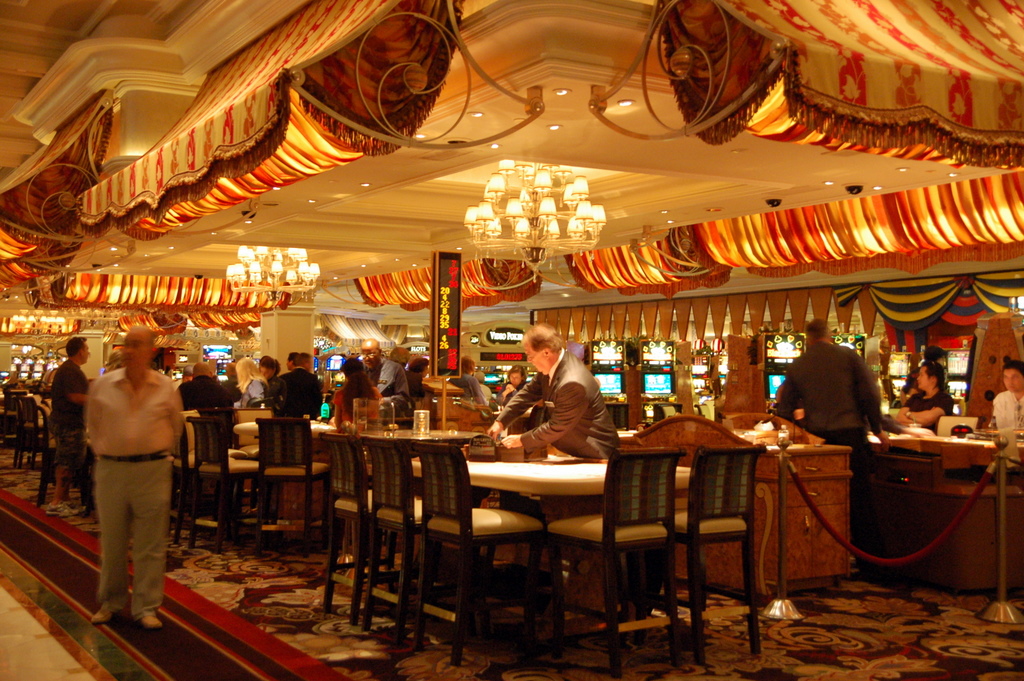
Drinking is good for business. That's why there are cocktail waitresses who wander the aisles between slots and game tables, offering you drinks to cloud your judgment. These waitresses vary in what you might call "quality" from one casino to the next, based on the overall "tone" of the place. At Bellagio (where they're actually called "Bellagio Babes") the girls are young and bouncy; at Circus Circus, which is way down the scale from Bellagio, they're downtrodden, middle-aged and...ahem...somewhat overweight.
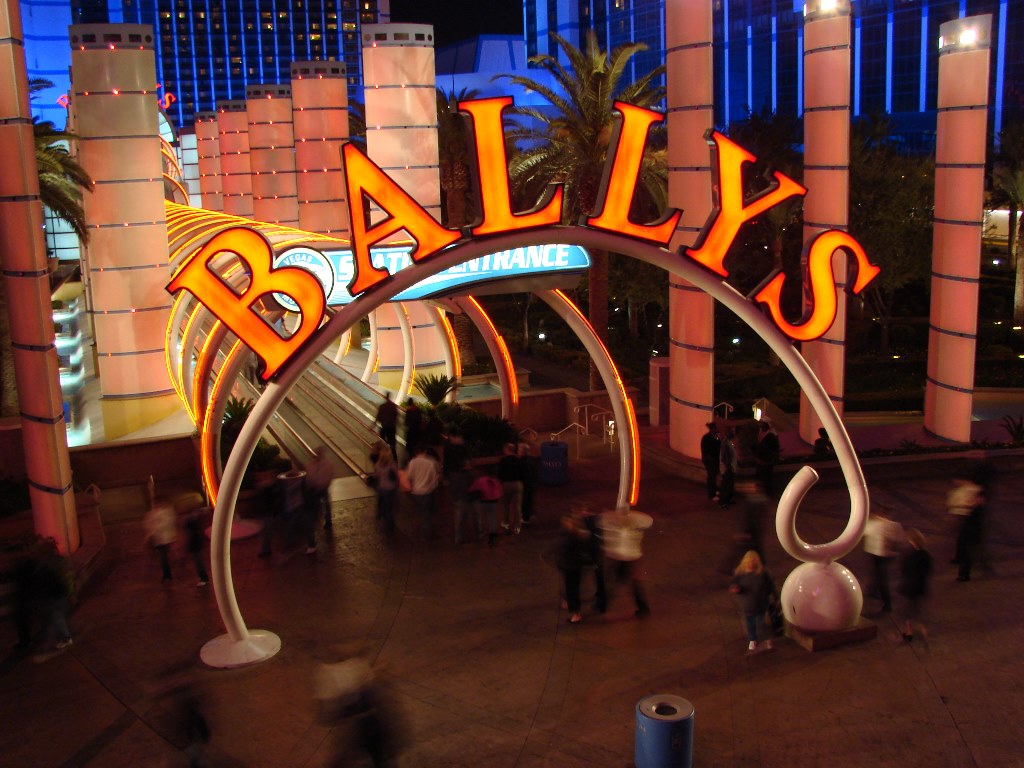
We stayed at Bally's, which was one of the SHOT convention hotels. It was in fact a
pretty nice place, much nicer than the Circus Circus (where I stayed last
year). C-C is...well, to be charitable, if you were looking for a two-word phrase to describe Circus Circus, "grubby dump" would come to mind. In their
defense, though, I have to say they do have a very good steak house (far better than the one at Bally's) and a
pretty decent buffet. Circus Circus was built almost 50 years ago 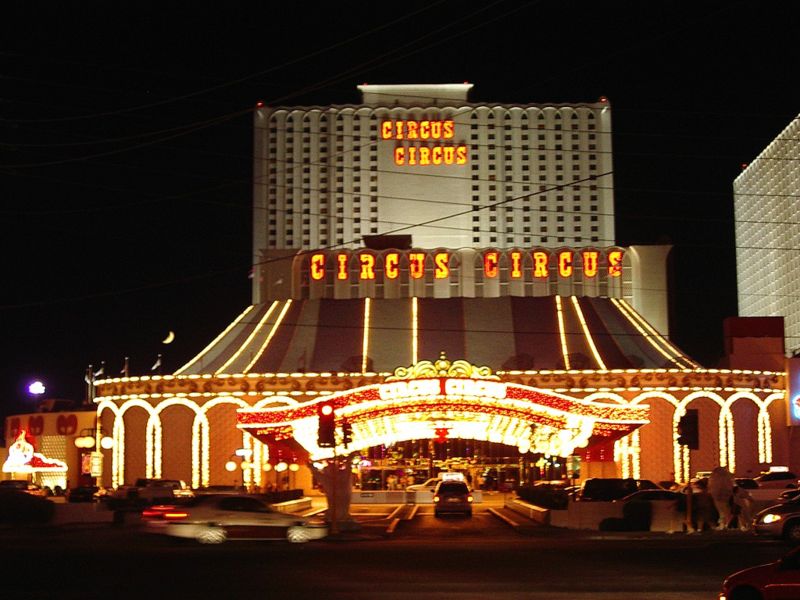 and caters to what you
might call "entry level" casino goers, mainly people who are hoping to win enough money to
afford the rent on their trailer for a few months.
and caters to what you
might call "entry level" casino goers, mainly people who are hoping to win enough money to
afford the rent on their trailer for a few months.
Bally's was at one time a really, really snazzy place, though it's been pushed
from the front ranks of what passes for classy in Vegas by upstarts like the
Venetian and Bellagio and Aria, all of which are much newer, flossier, and have far more
expensive Asian Fusion restaurants (and prettier cocktail waitresses). At
Bally's the slots don't have circus themes, as they do in C-C. They have classy themes like windmills, lions, and the odd "old style" grapes,
cherries, and bars. If they'd had one with rutabagas I might have played
it.
I had been advised by someone savvier than I to ask at check-in for an "upgrade" to my room. "Upgrades" and "comps" are a way of life in Las Vegas. The casinos all have their own variety of "comp" cards, something like supermarket loyalty cards. For every dollar you spend with them you get "points" that you can then trade for room upgrades, "free" plays at the games, "free" stuff in the restaurants, etc. Of course the point is to keep you spending your money within one casino group. I had no such card-you only get one if you're crazy enough to go to Las Vegas on a regular basis. Along with the rewards cards come various levels of points you can earn: Silver, Gold, Platinum, Ruby, Emerald, Diamond, Plutonium, etc. Not having a card gets put into the Base Metal category of guest (at Excalibur they have an Alchemist-In-Residence who will transmute Lead guests into Gold guests for only a modest investment). I found this unimportant. In my experience with large meetings, the hotels are very accommodating to people who are attending. SHOT probably brings in nearly 100,000 people for a four-day meeting (last year it was 85,00), most of whom are on expense accounts. So they like people who come in groups and the "comps" are readily available for the asking.
I
asked. The nice lady at the check-in desk turned out to have come from
my old neighborhood in Da Bronx, so perhaps that was a plus. She left for a few minutes, and returned to
tell me she "did some manipulation" and got us upgraded from a Lead Room
to a Diamond Room, and at no extra charge. So I got "comped." It was
quite nice, though the door rate card said the maximum charge for that room
was...$2500. Anyone who'd pay that much for the room we had would be in
clear need of a brain transplant.
Bally's group also owns the adjacent casino, Paris. We found that we could
stroll through the Shoppes between the two  without having to go out into the
bedlam on the streets, and the restaurants there were OK, better in fact than those in Bally's. All the food we
had in Las Vegas was decent, though like everything else it was overpriced,
except for the Bally's buffet, which was a very good deal.
without having to go out into the
bedlam on the streets, and the restaurants there were OK, better in fact than those in Bally's. All the food we
had in Las Vegas was decent, though like everything else it was overpriced,
except for the Bally's buffet, which was a very good deal.
We
did breakfast at the Bally's buffet twice, though Susan disapproved of my eating too
much of their excellent bacon (when it comes to bacon I am completely
incapable of shame or restraint) so we switched over to Paris' sidewalk cafe for a couple of
days. It was also excellent, though it was twice the price and I didn't
get enough bacon. As compensation they did have outstanding corned beef
hash. And though we were outdoors, there was a metal fence to separate us
from the drunks wandering the streets at 8:00 AM, of which Las Vegas has a
God's Plenty.
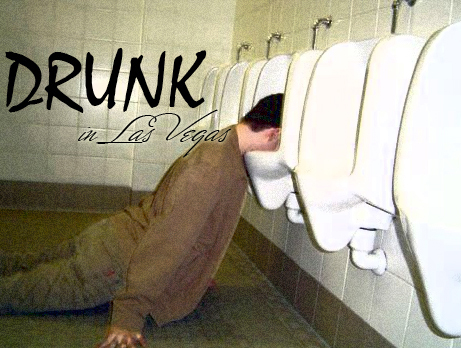 In Las Vegas drunks are usually far more amiable than your typical New Orleans
drunk, with whom I have all too close an acquaintance. New Orleans has
more weirdoes and nut-cakes and screwballs per square foot than any city I've
ever visited, and New Orleans drunks tend to be aggressive, obnoxious, and potentially dangerous.
But the Las Vegas drunks we encountered were usually tourists (male and female) who
were enjoying their visit immensely and being pretty exuberant about telling
everyone how good a time they were having. Or they were panhandlers on
the pedestrian bridges that crossed Las Vegas Boulevard.
In Las Vegas drunks are usually far more amiable than your typical New Orleans
drunk, with whom I have all too close an acquaintance. New Orleans has
more weirdoes and nut-cakes and screwballs per square foot than any city I've
ever visited, and New Orleans drunks tend to be aggressive, obnoxious, and potentially dangerous.
But the Las Vegas drunks we encountered were usually tourists (male and female) who
were enjoying their visit immensely and being pretty exuberant about telling
everyone how good a time they were having. Or they were panhandlers on
the pedestrian bridges that crossed Las Vegas Boulevard.
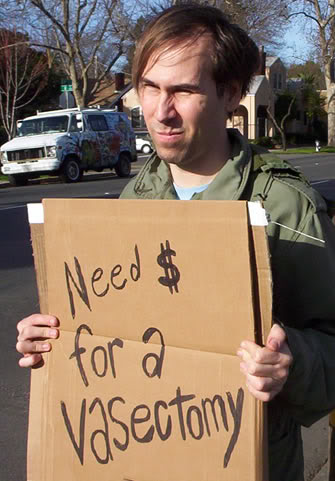 What
with the income taxes I'm paying, these days I tend to tell panhandlers to call the White
House and ask Obama for money, because that's where I sent all my spare Hope And Change. But I did
drop some money into the tin cup of one bedraggled guy on a pedestrian overpass. He was playing a guitar very,
very badly, and singing in a voice that reminded me of a dog with his hind leg
stuck in a fence. Anyone with that little talent and that much chutzpah deserved a few coins. At one point we
got hustled at a bus stop by a sad sack couple. The guy asked me if I could "spare a
dollar so the little lady could get something to eat." They had, however, just emerged from the Circus
Circus, and judging by his speech, for "eat" he meant "drink," so I ignored
him. One enterprising gent on
a pedestrian bridge had a sign that read, "Why lie? I just need another beer!" so I gave him a
dollar. Honesty pays off.
What
with the income taxes I'm paying, these days I tend to tell panhandlers to call the White
House and ask Obama for money, because that's where I sent all my spare Hope And Change. But I did
drop some money into the tin cup of one bedraggled guy on a pedestrian overpass. He was playing a guitar very,
very badly, and singing in a voice that reminded me of a dog with his hind leg
stuck in a fence. Anyone with that little talent and that much chutzpah deserved a few coins. At one point we
got hustled at a bus stop by a sad sack couple. The guy asked me if I could "spare a
dollar so the little lady could get something to eat." They had, however, just emerged from the Circus
Circus, and judging by his speech, for "eat" he meant "drink," so I ignored
him. One enterprising gent on
a pedestrian bridge had a sign that read, "Why lie? I just need another beer!" so I gave him a
dollar. Honesty pays off.
 Gambling and drinking aren't the only things to do in Las Vegas. You can
go to a girlie show, which we did—at my wife's suggestion, I hasten to
add, not that I needed a whole lot of convincing to go see semi-naked women. We went to "Jubilee!" which claims to be the longest
running such performance in the city, dating back to 1981. It was The
Real Thing, with statuesque showgirls wearing colossal headdresses and not much
else. If you have ever seen the terrible movie "Showgirls," well...it's
just like that. A number of very tall and very attractive women engaging
in public toplessness is a guaranteed moneymaker.
Gambling and drinking aren't the only things to do in Las Vegas. You can
go to a girlie show, which we did—at my wife's suggestion, I hasten to
add, not that I needed a whole lot of convincing to go see semi-naked women. We went to "Jubilee!" which claims to be the longest
running such performance in the city, dating back to 1981. It was The
Real Thing, with statuesque showgirls wearing colossal headdresses and not much
else. If you have ever seen the terrible movie "Showgirls," well...it's
just like that. A number of very tall and very attractive women engaging
in public toplessness is a guaranteed moneymaker.
 Along with the Busby-Berkley-cum-Ziegfeld-Follies opening number, there were
some acrobats (while the girls changed G-strings) a trio of Argentine
pseudo-Gauchos who spun boleadoras, and an incredibly dumb
"re-telling" of the story of Samson and Delilah. This last was a
major production, complete with crashing temple pillars, flashing lights, etc.
as the Philistines (the ones on stage, not the ones in the audience) scurried
about naked as jaybirds, the male ones flexing their pectorals and the female
ones bouncing their mammaries and yelling hysterically. Everyone was so
deadly serious it was all I could do not to break out laughing. There
was also a completely-clothed depiction of the sinking of Titanic.
It was probably a good thing they did have the girls keep their clothes on for that number: after all, there was a very real chance of some of them dying of exposure, even during the
fire-and-brimstone of the Samson skit. If
they'd been nekkid in the simulated winter North Atlantic they'd have died for
sure, and wouldn't THAT be a waste?.
Along with the Busby-Berkley-cum-Ziegfeld-Follies opening number, there were
some acrobats (while the girls changed G-strings) a trio of Argentine
pseudo-Gauchos who spun boleadoras, and an incredibly dumb
"re-telling" of the story of Samson and Delilah. This last was a
major production, complete with crashing temple pillars, flashing lights, etc.
as the Philistines (the ones on stage, not the ones in the audience) scurried
about naked as jaybirds, the male ones flexing their pectorals and the female
ones bouncing their mammaries and yelling hysterically. Everyone was so
deadly serious it was all I could do not to break out laughing. There
was also a completely-clothed depiction of the sinking of Titanic.
It was probably a good thing they did have the girls keep their clothes on for that number: after all, there was a very real chance of some of them dying of exposure, even during the
fire-and-brimstone of the Samson skit. If
they'd been nekkid in the simulated winter North Atlantic they'd have died for
sure, and wouldn't THAT be a waste?.
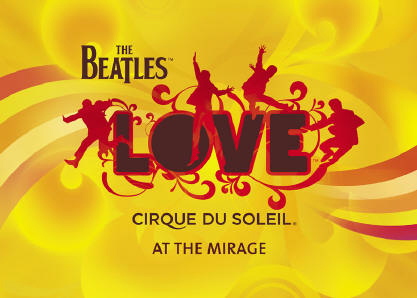
 We went also to see one of the shows put on by Cirque du Soleil, which I hadn't
realized was a sort of franchise operation. There are four or five Cirque
du Soleil shows running in Las Vegas at the moment. We went to
"Love," which was set to (ugh) Beatles music. I'm not much
interested in rock music, and even less so in Beatles music. I am
especially uninterested in Beatles music that is post-Sergeant Pepper, and that's the period from which nearly all the pieces chosen were drawn.
We went also to see one of the shows put on by Cirque du Soleil, which I hadn't
realized was a sort of franchise operation. There are four or five Cirque
du Soleil shows running in Las Vegas at the moment. We went to
"Love," which was set to (ugh) Beatles music. I'm not much
interested in rock music, and even less so in Beatles music. I am
especially uninterested in Beatles music that is post-Sergeant Pepper, and that's the period from which nearly all the pieces chosen were drawn.
I
will however have to give Cirque du Soleil its due: it's an amazing troupe of acrobats,
performing really dangerous stunts on ropes and bungee cords and trapezes,
a group of incredibly energetic performers with a great deal of talent. Although
"Love" was somewhat...well, bizarre, actually, in terms of staging
and costumes, the show was remarkably well done. At one point the entire
audience was covered with a billowing white sheet that was intended to represent the waters in which The Yellow Submarine sailed (submerged?).
They were projecting Yellow Submarine pictures on to it.
 Unfortunately it hadn't occurred to me beforehand that they would be doing so, but-inevitably, I now realize-the
show closed with a rousing rendition of the song "All You Need Is Love."
Now, this is an anthem that I've always found more than ordinarily asinine,
even for the Beatles and even for John Lennon. Having lived through that period I simply can't understand how
anyone can be nostalgic about the 60's, but Cirque du Soleil certainly
recognizes that this feeling exists and that it has great commercial value: the
audience was entirely composed of Baby Boomers, with whom this sort of music
really resonated: I was the odd man out in that respect. It's worth
noting that not one of the cast, of course, was actually able to remember the Beatles, pre- or post-Sergeant Pepper. None of them was as old
as 30. By the time any of them had been born, Lennon had been shot, and by the time some of them were born, George Harrison had died of cancer and Paul McCartney was collecting Social Security checks. You can't fling yourself around on a trapeze and jump between
billowing curtains fifty feet above a wooden stage if you're much over that age-not
if you want to live to tell the tale.
Unfortunately it hadn't occurred to me beforehand that they would be doing so, but-inevitably, I now realize-the
show closed with a rousing rendition of the song "All You Need Is Love."
Now, this is an anthem that I've always found more than ordinarily asinine,
even for the Beatles and even for John Lennon. Having lived through that period I simply can't understand how
anyone can be nostalgic about the 60's, but Cirque du Soleil certainly
recognizes that this feeling exists and that it has great commercial value: the
audience was entirely composed of Baby Boomers, with whom this sort of music
really resonated: I was the odd man out in that respect. It's worth
noting that not one of the cast, of course, was actually able to remember the Beatles, pre- or post-Sergeant Pepper. None of them was as old
as 30. By the time any of them had been born, Lennon had been shot, and by the time some of them were born, George Harrison had died of cancer and Paul McCartney was collecting Social Security checks. You can't fling yourself around on a trapeze and jump between
billowing curtains fifty feet above a wooden stage if you're much over that age-not
if you want to live to tell the tale.
Las Vegas isn't a city noted for its museums, but we visited two exhibitions
that were very well done, indeed: both of them were in the Luxor. One was "Bodies," a display of
dissected human anatomical specimens that has counterparts in several
cities. This wasn't (as one might have expected in Las Vegas)
exploitative or sensationalistic. It was very educational and presented
in good taste (again, not something for which Las Vegas has much of a
reputation) and rather subdued. Technically it was stunningly well done:
I'm a professional anatomist and I know what dissection of that kind involves:
it's as much an art as anything else, and these dissections were fabulously
executed. Long ago I met the man who developed the technique used in the
preservation of these displays (Gunter Haagens, a very, very strange guy) and
while he's been charged with sensationalizing death, I think on the whole he is
performing a very valuable service to the public. And if he gets very
rich in the process, so much the better.
 The other exhibit was "Titanic," which dovetailed nicely with the skit that Jubilee put on, I thought. Luxor is a "family" place so there weren't any naked women in their version. Instead they had a collection of artifacts
salvaged from the ship, along with reconstructions of various aspects of life
aboard (First, Second, and Third class cabins, the Grand Stairway, etc) as well
as a display on the methods of salvaging and preserving the items, and a
history of the ship's construction. The presentation include a mock-up of
the Promenade Deck, complete with (a real) mini-iceberg sticking over the
rail. The artifacts were tastefully presented. One very interesting
touch was that upon entry you were given a "boarding pass," a
reproduction of an actual pass, issued to a real passenger. At the end of
the exhibit, there was a wall with the complete passenger list, and you could
read it to see whether "you" survived the sinking.
The other exhibit was "Titanic," which dovetailed nicely with the skit that Jubilee put on, I thought. Luxor is a "family" place so there weren't any naked women in their version. Instead they had a collection of artifacts
salvaged from the ship, along with reconstructions of various aspects of life
aboard (First, Second, and Third class cabins, the Grand Stairway, etc) as well
as a display on the methods of salvaging and preserving the items, and a
history of the ship's construction. The presentation include a mock-up of
the Promenade Deck, complete with (a real) mini-iceberg sticking over the
rail. The artifacts were tastefully presented. One very interesting
touch was that upon entry you were given a "boarding pass," a
reproduction of an actual pass, issued to a real passenger. At the end of
the exhibit, there was a wall with the complete passenger list, and you could
read it to see whether "you" survived the sinking.
I didn't, but Mrs NRVO did. She was a First Class passenger (the Duchess of
Somewhere) but I was in steerage, a mere immigrant from Switzerland looking for
work in America as a common laborer. The casualty list, sorted by class,
was a mute indictment of the social system of the time. Well over half
the dead were steerage passengers. Titanic was equipped with
inadequate numbers of lifeboats, with the proportion for Third class being much
smaller than First class. If you were in steerage you weren't allowed in
the First class boats even if there was room! The sinking and the
disproportionate loss of life led to some significant changes in that system,
and regulations were changed: lifeboats enough for everybody, and to hell with
the class you were traveling in.
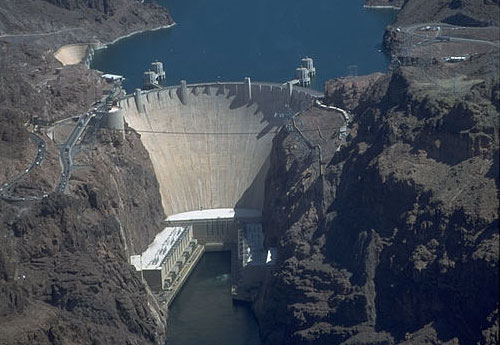 One day we went to Hoover Dam, another sight well
worth the trip. It was my second visit, and it was as impressive as the
first. Hoover Dam was built in two years less than the original time estimate and came in several million
dollars under budget. Of course
in 1931 there was no EPA, no Environmental Impact Statements, no OSHA, no
alphabet soup of regulatory agencies with their oars in the water, and no
eco-Nazis. As valuable and as important as it is—Los Angeles, most of
southern California, and the agricultural areas of the San Joaquin Valley couldn't exist without it—Hoover Dam absolutely couldn't be built today under any circumstances. Amazingly, there are actually people who want it removed! If that happened LA would dry up and blow away...well, come to think of it, maybe it's not
such a bad idea.
One day we went to Hoover Dam, another sight well
worth the trip. It was my second visit, and it was as impressive as the
first. Hoover Dam was built in two years less than the original time estimate and came in several million
dollars under budget. Of course
in 1931 there was no EPA, no Environmental Impact Statements, no OSHA, no
alphabet soup of regulatory agencies with their oars in the water, and no
eco-Nazis. As valuable and as important as it is—Los Angeles, most of
southern California, and the agricultural areas of the San Joaquin Valley couldn't exist without it—Hoover Dam absolutely couldn't be built today under any circumstances. Amazingly, there are actually people who want it removed! If that happened LA would dry up and blow away...well, come to think of it, maybe it's not
such a bad idea.
 Of course, I really went to attend the SHOT Show, right? Gun Digest assigned me to do the "Airgun Report" for their 2012 Edition, so I spent two days
dutifully hitting every booth related to air guns and airsoft, more or less
ignoring the rest of the stuff on display. I found last year that you can walk yourself to death if you try to see everything. As to the non-airgun parts of the show, everything was much the same as last year, though
a little less chaotic in the layout. I also had the impression it was
less "tactical" as well. Last year there were, so help me,
"tactical" squirrel rifles, complete with Picatinny rails and laser
sights, etc. on offer.
Of course, I really went to attend the SHOT Show, right? Gun Digest assigned me to do the "Airgun Report" for their 2012 Edition, so I spent two days
dutifully hitting every booth related to air guns and airsoft, more or less
ignoring the rest of the stuff on display. I found last year that you can walk yourself to death if you try to see everything. As to the non-airgun parts of the show, everything was much the same as last year, though
a little less chaotic in the layout. I also had the impression it was
less "tactical" as well. Last year there were, so help me,
"tactical" squirrel rifles, complete with Picatinny rails and laser
sights, etc. on offer.
 There
were some interesting developments in airguns-Crosman has a .357 bore rifle out that personally I believe is destined for failure-but the
rest of what was shown was little more than continuing to ring the changes on AR-15's and Glocks, as
always. The hit of the show was Kel-Tec's new police shotgun. It's one
ugly mother, a real brute ofa bull pup, with parallel magazine tubes to allow
switching from slugs to buckshot at will. It's made for police use, but
it's
"street legal" for regular ownership, as the barrel and overall length meet Federal minimum standards. It would certainly give the most hardened home intruder pause to think about choosing another career.
There
were some interesting developments in airguns-Crosman has a .357 bore rifle out that personally I believe is destined for failure-but the
rest of what was shown was little more than continuing to ring the changes on AR-15's and Glocks, as
always. The hit of the show was Kel-Tec's new police shotgun. It's one
ugly mother, a real brute ofa bull pup, with parallel magazine tubes to allow
switching from slugs to buckshot at will. It's made for police use, but
it's
"street legal" for regular ownership, as the barrel and overall length meet Federal minimum standards. It would certainly give the most hardened home intruder pause to think about choosing another career.
I stopped by Shaw Rifles' booth, because last September I ordered one of their Mark VII rifles for my next safari. I had wanted to see an example of their
high-polish blue compared to the matte finish, but when I told them I was there on behalf of Gun Digest the sales manager promised to expedite
production and perhaps give me a writer's discount! I'm pleased to say that I got the .416 in time to go to
the Caprivi and shot my elephant with it in 2013.